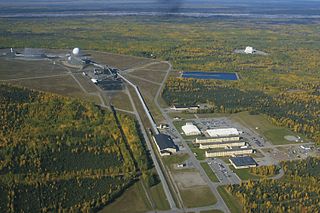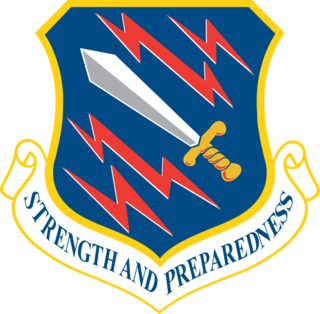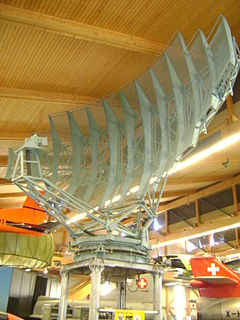
PAVE PAWS is a complex Cold War early warning radar and computer system developed in 1980 to "detect and characterize a sea-launched ballistic missile attack against the United States". With the first solid-state phased array deployed, the system used a pair of Raytheon AN/FPS-115 phased array radar sets at each site to cover a wide azimuth angle of 240 degrees. Two sites were deployed in 1980 at the periphery of the contiguous United States, then two more in 1987–95, as part of the United States Space Surveillance Network. One system was sold to Taiwan and is still in service.

The RCA 474L Ballistic Missile Early Warning System was a United States Air Force Cold War early warning radar, computer, and communications system, for ballistic missile detection. The network of twelve radars, which was constructed beginning in 1958 and became operational in 1961, was built to detect a "mass ballistic missile attack launched on northern approaches [for] 15 to 25 minutes' warning time" also provided Project Space Track satellite data.

Royal Air Force Fylingdales or more simply RAF Fylingdales is a Royal Air Force station on Snod Hill in the North York Moors, England. Its motto is "Vigilamus". It is a radar base and is also part of the Ballistic Missile Early Warning System (BMEWS). As part of intelligence-sharing arrangements between the United States and United Kingdom, data collected at RAF Fylingdales are shared between the two countries. Its primary purpose is to give the British and US governments warning of an impending ballistic missile attack. A secondary role is the detection and tracking of orbiting objects; Fylingdales is part of the United States Space Surveillance Network. As well as its early-warning and space-tracking roles, Fylingdales has a third function – the Satellite Warning Service for the UK. It keeps track of spy satellites used by other countries, so that secret activities in the UK can be carried out when they are not overhead. The armed services, defence manufacturers and research organisations, including universities, take advantage of this facility.

The United States Space Surveillance Network (SSN) detects, tracks, catalogs and identifies artificial objects orbiting Earth, e.g. active/inactive satellites, spent rocket bodies, or fragmentation debris. The system is the responsibility of United States Space Command and operated by the United States Space Force.

Over-the-horizon radar (OTH), sometimes called beyond the horizon (BTH), is a type of radar system with the ability to detect targets at very long ranges, typically hundreds to thousands of kilometres, beyond the radar horizon, which is the distance limit for ordinary radar. Several OTH radar systems were deployed starting in the 1950s and 1960s as part of early warning radar systems, but these have generally been replaced by airborne early warning systems. OTH radars have recently been making a comeback, as the need for accurate long-range tracking becomes less important with the ending of the Cold War, and less-expensive ground-based radars are once again being considered for roles such as maritime reconnaissance and drug enforcement.

Clear Space Force Station is a United States Space Force radar station for detecting incoming ICBMs and submarine-launched ballistic missiles to NORAD's command center and to provide Space Surveillance data to the United States Space Force. Clear's AN/FPS-123 Upgraded Early Warning Radar is part of the Solid State Phased Array Radar System (SSPARS) which also includes those at Beale AFB, Cape Cod Space Force Station, RAF Fylingdales and Thule Site J. The "historic property" was one of the Alaska World War II Army Airfields and later a Cold War BMEWS site providing NORAD data to Colorado's BMEWS Central Computer and Display Facility (CC&DF).

The Jindalee Operational Radar Network (JORN) is an over-the-horizon radar (OHR) network that can monitor air and sea movements across 37,000 square kilometres (14,000 sq mi). It has a normal operating range of 1,000 kilometres (620 mi) to 3,000 kilometres (1,900 mi). It is used in the defence of Australia, and can also monitor maritime operations, wave heights and wind directions.

The AN/FPS-108 COBRA DANE is a PESA phased array radar installation operated by Raytheon for the United States Space Force at Eareckson Air Station on the island of Shemya, Aleutian Islands, Alaska. The system was built in 1976 and brought online in 1977 for the primary mission of gathering intelligence about Russia's ICBM program in support of verification of the SALT II arms limitation treaty. Its single face 29 m (95 ft) diameter phased array radar antenna 52.7373°N 174.0914°E faces the Kamchatka Peninsula and Russia's Kura Test Range. COBRA DANE operates in the 1215–1400 MHz band.

The AN/FPS-117 is an L-band active electronically scanned array (AESA) 3-dimensional air search radar first produced by GE Aerospace in 1980 and now part of Lockheed Martin. The system offers instrumented detection at ranges on the order of 200 to 250 nautical miles and has a wide variety of interference and clutter rejection systems.

Fort Fisher Air Force Station was a United States Air Force installation located on the Atlantic coast 0.8 miles (1.3 km) southwest of Kure Beach, North Carolina. Its primary mission was as a radar complex. It was closed on 30 June 1988 by the Air Force, and turned over to the Federal Aviation Administration (FAA).

The 21st Space Wing was the United States Space Force's ground–based missile warning and space control wing. The 21st Space Wing was assigned to Space Operations Command and headquartered at Peterson Air Force Base, Colorado. The 21st Space Wing controlled Peterson Air Force Base, Cheyenne Mountain Air Force Station, Thule Air Base, Clear Air Force Station, Cape Cod Air Force Station, and Cavalier Air Force Station.

The Space Fence is a second-generation space surveillance system operated by the United States Space Force in order to track artificial satellites and space debris in Earth orbit.

The Medicina Radio Observatory is an astronomical observatory located 30 km from Bologna, Italy. It is operated by the Institute for Radio Astronomy of the National Institute for Astrophysics (INAF) of the government of Italy.

The 20th Space Surveillance Squadron is a Space Delta 2 unit located at Eglin Air Force Base, Florida with the mission to execute multiplatform, tactical space warfighting domain characterization, recognition, and responsiveness to achieve 21st Space Wing and United States Space Command intent. The unit, formerly designated the 20th Space Control Squadron, was renamed on 25 March 2022.
Pirinçlik Air Base, also known as Pirinçlik Air Station, formerly Diyarbakır Air Station, was a 41-year-old American-Turkish military base near Diyarbakir, Turkey. It was known as NATO's frontier post for monitoring the former Soviet Union and the Middle East, completely closed on 30 September 1997.

GRAVES is a French radar-based space surveillance system, akin to the American Air Force Space Surveillance System. Using radar measurements, the French Air Force is able to spot satellites orbiting the Earth and determine their orbit. The GRAVES system took 15 years to develop, and became operational in November, 2005. GRAVES is also a contributing system to the European Space Agency's Space Situational Awareness Programme (SSA).
Ground Equipment Facility J-36A is a Federal Aviation Administration (FAA) radar station of the Joint Surveillance System (JSS) in the Western Air Defense Sector (WADS) of NORAD.

Mount Laguna Air Force Station is a closed United States Air Force General Surveillance Radar station. It is located 24.3 miles (39.1 km) north-northeast of Tecate, California. It was closed in 1981 by the Air Force, and turned over to the Federal Aviation Administration (FAA).

The SFR Airspace monitoring and management system was the first Airspace monitoring and management system of the Swiss Air Force.

Eglin AFB Site C-6 is a United States Space Force radar station which houses the AN/FPS-85 phased array radar, associated computer processing system(s), and radar control equipment. Commencing operations in 1969, the AN/FPS-85 was the first large phased array radar. The entire radar/computer system is located at a receiver/transmitter building and is supported by the site's power plant, fire station, 2 water wells, and other infrastructure for the system. As part of the US Space Force's Space Surveillance Network its mission is to detect and track spacecraft and other manmade objects in Earth orbit for "the Combined Space Operations Center satellite catalogue". With a peak radiated power of 32 megawatts the Space Force claims it is the most powerful radar in the world, and can track a basketball-sized object up to 22,000 nautical miles (41,000 km) from Earth.


















